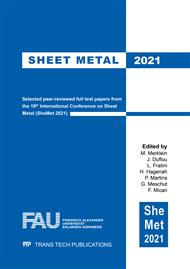p.175
p.181
p.189
p.195
p.201
p.209
p.217
p.227
p.234
On the Effectiveness of SPIF Process to Re-Form End-of-Life Components as Compared to Conventional Forming Approach
Abstract:
Manufacturing processes have a significant impact on global energy consumptions. The recovery of materials and functions for the implementation of the Circular Economy principle needs to be focused on either, by utilizing new techniques or the rethinking of old processes to rework End-of-life (EoL) components. Previous researches have shown Single Point Incremental Forming (SPIF) process as a good alternate for sheet metal EoL components reuse by their reshaping. In this article, the authors aim to study the effectiveness of the SIPF processes by comparing its reshaping performance with other, more conventional forming processes. An initial deep drawing process was performed to imitate aluminum sheet metal EoL component, subsequently, different stretching-based reshaping approaches have been tested. Results revealed that SPIF outperformed conventional forming processes, as proved to be the only approach leading to new/reshaped component
Info:
Periodical:
Pages:
201-208
Citation:
Online since:
April 2021
Authors:
Keywords:
Price:
Сopyright:
© 2021 Trans Tech Publications Ltd. All Rights Reserved
Share:
Citation:


